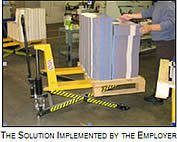
(888) 782-8338

ErgoMatters℠ is moving to SafeAtWorkCA.com, State Fund’s safety resource center. Click the link below to find all of our ErgoMatters content. ErgoMatters on SafeAtWorkCA.com |
In many manufacturing environments, products are most likely stacked on pallets, both in the shipping and receiving departments, as well as when transferring products from one department to the next. Pallets are typically stacked on the floor, which makes it convenient for moving product with either a forklift or pallet jack, but very inconvenient for employees who have to load and unload the pallets.
Consider the job task pictured below. Here, the employee bends over to put stock onto a pallet. The pallet is 6" high. The action of 'building' a pallet forces the back into extreme trunk flexion. Trunk flexion increases the stresses placed on the low back. Bending forward at the waist moves the body’s center of gravity away from its midpoint. Hence, both the weight of the upper body and the object being handled must be lifted. This increases the demands on the soft tissues (muscles, tendons, ligaments) and discs of the low back with or without any material being lifted or lowered.

Raising the height of the pallet, to neutral or waist height as the pallet is loaded or unloaded, significantly reduces the need to constantly bend, stoop, and squat. Tying up a forklift all day to raise or lower the pallet’s working height to keep it at the employee’s waist height is neither feasible nor practical. The goal is to never let trunk flexion exceed 6° to 10° from vertical, especially for repetitive lifting and lowering jobs. High forces placed on the low back muscles and discs are significantly reduced when adjusting the height of the work surface. The most effective way to raise and lower work surfaces, especially in work processes that require varying heights, is to consider lift tables or scissor-lift carts appropriate for the job. A variety of different lift tables and scissor-lift carts are available, to provide a solution specific to the task(s) under consideration.

Revised: 04/2017